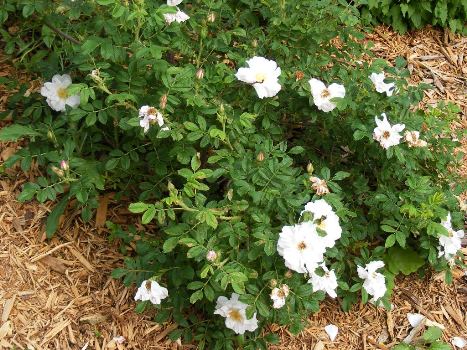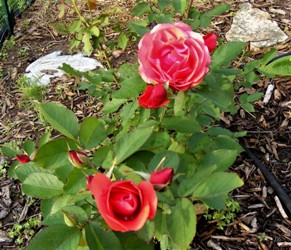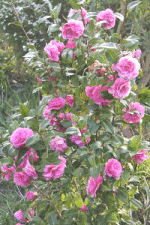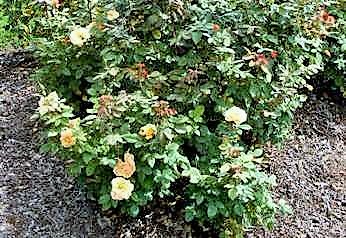Selecting the Perfect Rose for Your Garden
Growing roses in a Midwest climate is getting easier all the time. Although hybrid tea roses will always require a great deal of time and effort in the north, there are many other varieties of rosebushes to choose from now that are hardy and fuss free, and still beautiful. All roses from hardy, low maintenance shrub roses, to demanding hybrid tea roses, require the basics:
A minimum of 6 hours sun between 9 am and 4 pm, all day if possible
Good soil amended with 1 or 2 shovelfuls of compost and peat moss for good drainage
One inch of water per week
Good air circulation, with gentle breezes if possible
Feeding with low nitrogen, balanced fertilizer every spring
Pruning of damaged and wayward branches.
Try to buy “own root” roses whenever possible. If the plant dies back to the ground, the roots will reproduce a true plant. Grafted roses are grafted to hardy rootstock of an unidentified rose. So if a grafted rose dies to the ground, the plant that regrows will be unrecognizable. When buying graded roses, always buy a grade 1 or 1 1/2 plant. Grade 1 is the best and will have 3 or more 18” canes; Grade 1 1/2 has 2-15” canes, and grade 2 has 2-12” canes. If you buy a grade 2, it is a grade 2 forever, you cannot nuture it to a grade 1.
The hardiest and most self-sufficient rose bushes require no more, and some are even quite tolerant of neglect. They are an ideal candidate for difficult to access areas for watering and frequent tending, such as hillsides. Lets start with those.
Rugosa Roses
These tough and rugged roses are a busy, or lazy, gardener’s dream. They thrive in poor conditions, are very content even when neglected, and are highly disease resistant. As a matter of fact, they often don’t react well to fungicides, which may cause leaves to yellow and drop. They don’t have the classic look of a tea rose, but they produce masses of textured single blooms that are highly fragrant and long lasting. Sometimes known as the salt spray rose, rugosas are known to grow wild along coastlines and sea islands. The rose bush is a little on the wild side, and some can reach 7 feet. The leaves are deeply crinkled, with tiny hairs that give them resistance to disease. Rugosas can withstand poor, compacted soil, heat, and salt, making them a perfect solution for roadside beds, or hotzones along blacktop drives. They require no winter protection and are hardy to zone 3, and sometimes in zone 2. North of zone 4, they require winter protection of compost at, and around the base of the rose bush They do best in cool regions throughout the Midwest and Northeast.
Most rugosas bloom in June, with two later flushes of bloom. Deadheading when blooms are spent may encourage blooming, but failing to deadhead does not necessarily seem to diminish blooming significantly. The Topaz Jewel Rugosa at right has all three stages of bloom. On the bottom you see fresh green foliage with a flower bud. In the center is dark mature foliage with spent blooms, and and top is medium green foliage in full bloom. This all happens without gardener intervention! How nice! The blooms at end of season should be left on the bush to form colorful rose hips to brighten your winter landscape. The foliage generally remains healthy and lush into fall, then turns shades of gold and red. Many other roses have wilted, discolored or dropped leaves by end of season due to disease.
Plant rugosas in early spring or early fall, in poor to average soil. For best health, enrich the soil with compost and water well. Supplement rain with watering up to and inch per week, and fertilize with a low nitrogen balance fertilizer the first of May, June and July at most. A granular slow release fertilizer in the spring really should be enough. If you neglect the watering or fertilizer, your rugosa won’t mind much. Prune only dead wood which may be caused by inconsistent snow cover, or significantly crossed or wayward branches. Rugosa bushes tend to be a bit loose and wild, so allow the branches to assume their natural form. Deadhead wilted flowers to encourage heavier blooming. The petals will often begin dropping themselves, but the flower head should be removed. Petal drop is the only drawback to the rugosa roses, the highly perfumed blooms do not hold their petals very long for a cut flower. Find Rugosa Roses in the Rose Index.
Canadian Roses, Explorer and Parkland Series
Developed in Canada, these rose bushes are hardy down to -35 degrees. The only winter protection they need is snow. If snow is inconsistent in your area, protection with compost, shredded leaves, or heavy mulch at the base of the plant will protect adequately. Individual varieties may be hardy between zones 2 and 3 as noted, and of course the zone 3 Canadians can survive with protection in zones north. They are highly disease resistant and flower repeatedly through the season. Canadian Roses are bred from rugosas or Kordessi hybrids, and have retained the cold hardy and disease resistant attributes, and thrive in hot humid summers. Although they don’t bloom continuously like the hybrid tea roses, many are repeat bloomers.
Like the rugosas, fertilize minimally, up to three times early and mid season, or with a single application of granular slow release 10-10-10 fertilizer. Do not over prune, allowing them to assume their natural form as much as possible. If inconsistent snow has caused some dieback, just prune out dead limbs. Old woody canes may also be pruned out, as they tend to become unproductive. And don’t spray for disease, as unnecessary spraying may cause leaves to turn yellow and drop.
Canadian roses tend a bit more toward elegance than rugosas, appearing similar to shrub roses , and some varieties similar to floribundas. Climbing roses are also available in the the Canadian series, hardy enough to leave on your trellis all winter. Find Canadian Roses in the Rose Index.
Classic and Modern Shrub Roses
This category has become very broad, often described as shrub roses or landscape roses, and includes many varieties that are generally hardy to zones 3 or 4. And some of these are even floribunda shrub roses. However some may need at least moderate winter protection even in zone 4, but should not need to be Minnesota tipped. You will find these marketed as “Easy Elegance Roses”, Knock-Out Series Roses, and Simplicity Roses (however the Simplicity is only marginally hardy to zone 4 - best in zone 5). Knock Out Roses have grown to a famous family of rose bushes. They are easy to grow and keep healthy, as they are disease and pest resistant. The foliage is dense and lush without spraying for mildew and black spot. Continuous reblooming without deadheading is another bonus, as well as colorful hips in winter. Virtually no pruning is necessary other than cutting out dead or damaged branches. All are advertised as hardy to zone 4, but minimal protection is highly advisable in most of zone 4, and the further north you are, moderate protection is advised. “Officially”, to qualify as hardy the plant must survive repeated winters without protection. But since winter is different all over the north and midwest, I have tried to give hardiness guidance by zone for this category.
Shrub Roses can be planted in average soil with good drainage, and organic matter (compost and/or peat moss) should be worked into the soil. Water an inch per week, and fertilize 1 to 3 times early to mid season as with the rugosas and Canadian roses. Deadheading encourages reblooming, but as you can see in the picture at left, most continuous blooming roses will keep blooming without deadheading. Several new flower buds are in the foreground, fully open bloom at right, and spent blooms on the top. This cycle is continous without gardener intervention, a nice bonus with these easy care roses. Most of these shrub roses are disease resistant and some are pest resistant. Many shrub roses have floribunda or hybrid tea roses somewhere in their genetic make up, so they display more of the classic rose characteristics in flower and growth habits.
Because this general category has grown so broad, there is a vast variety of attributes and characteristics. It is important to check the details and recommendations for each individual variety that you consider. Find Shrub and Landscape Roses in the Rose Index.
Polyantha Roses
Often referred to as patio roses, these small shrub roses are perfect for container planting or edging borders because of their non stop blooming habit. Spreading varieties are lovely trailing over rock gardens or garden walls. The more compact mounded varieties are ideal for formal gardens and accenting foundation plantings.
‘Fairy Rose’ and Cecile Brunner are the most widely known, and planted, of the Polyanthas, but there are many many more. Like modern shrub roses, they are hardy and disease resistant. Polyantha blooms are tiny, usually about 1”, born in large sprays and bloom non stop from spring until frost. The roses bloom in typical colors including white, pink and red. Polyanthas, being a parent of the floribunda roses, are prolific bloomers. Some are fragrant, and some have few or no thorns.
They prefer a moderate climate but will tolerate intense sun, although they do not perform as well in high temperatures. They will also tolerate alkaline soils and salt. The shrub itself is generally very healthy and disease resistant, but may occasionally show a bit of blackspot in southern regions. Some are very cold hardy and can thrive in zone 4. Should winter die back occur, they will grow back quickly after spring tip pruning and removal of dead canes. In zones colder than zone 4, protection would be required. Minimal to moderate should be adequate in zones 3 and 4 for most polyanthas.
Plant Polyantha roses 18 inches apart in cooler climates, 30 inches apart in warmer climates. Removing spent blooms may encourage reblooming, but Polyanthas rebloom repeatedly without deadheading. Find Polyantha Roses in the Rose Index.
Floribunda Roses
Floribundas bloom in large dense clusters, with many blooms opening simultaneously. The blooms are considered to be “less perfect” than a hybrid tea, and are not always scented, but do produce more blooms than a hybrid tea. They are generally less fussy and healthier than a tea rose. There are also, as noted above, floribunda shrub roses, which are generally just the hardier, bushier floribundas. Generally floribunda roses need at least 3 years to reach maturity. Once the root system is well established, floribunda roses will bloom heavier and become strong vigorous shrubs.
Floribunda roses should be planted quite strictly to the instructions mentioned on the previous page. There are northern gardeners who swear that floribundas do not need nearly the care in planting and attention to summer care as the tea rose. However the range of adaptability and hardiness is quite wide in this category of rose bushes. It seems, the more like a tea rose it looks, the more care it will require. Ideally, you should purchase bare root floribundas rather than potted, and place the roots into a bucket of water as soon as you get them home. There they should stay until they go into the ground. Then trim the roots to about 10 inches to encourage new tiny roots that do all the feeding to the bush. Make sure your soil is well amended with manure, compost and peat moss, I dare say you can not over amend the soil for floribundas and tea roses. Mix in a handful or two of bone meal to encourage root development. Plant in full sun 18-24” apart. Floribundas need good air circulation. Be sure and prune back the canes to 8-10”, or 3 or 4 bud bumps. Once growth has begun, feed with rose fertilizer, and feed every month until the end of July. Such heavy bloomers need regular feedings, no skipping feedings with floribundas!
Pruning should be done in early spring, before growth begins. Remember that a floribunda is grown in a bush form. Leave a strong bush structure of sturdy canes. Only spindly, weak canes, or crossed and wayward canes should be pruned harshly. Floribundas are grafted onto hardy, disease resistant rootstock. If you see a sucker shoot coming from the base of the bush, do NOT snip it. This shoot comes from the rootstock and will NOT produce a floribunda cane, so it needs to be removed completely with it’s growth bud. Remove soil all the way to the base of the shoot, deep enough to grasp the shoot at the base and pull sharply DOWNWARD. This should remove the growth bud and prevent it from regrowing.
Like hybrid tea roses, floribundas generally are grafted. They tend to be hardier than a tea rose, but still require winter protection. Zone 6 should be minimally protected, and zone 5 should do fine with minimal to moderate protection, decide based on how close you are to zone 4 or zone 6. In zone 4, moderate protection may be adequate, especially in a sheltered spot. North of zone 4, the Minnesota Tip would be advisable for many floribundas. Do check individual plant specifications or with your local garden center for specific information. Find Floribunda Roses in the Rose Index.
Grandiflora Roses
Grandiflora is a cross between floribundas and hybrid tea roses. Planting and care instructions should be followed as described for Floribunda and Tea Roses. Grandiflora Roses bloom continuously through the season with clustered blossoms, but generally are not as fragrant as a hybrid tea. Although the plant is tall and elegant, it is slightly shorter than the hybrid teas rose. Grandiflora is hardier than the tea rose and like the floribunda, they can be hardy up to zone 4. Winter protect as you would a floribunda, perhaps erring on the side of overprotection since they inherit some characteristics of theHybrid Tea Rose. Find Grandiflora Roses in the Rose Index.
Hardy Hybrid Tea Roses
A collection of hardy hybrid tea roses was developed by the Brownell family of rosarians and breeders, and named Sub-Zero. The objective in developing this collection was to produce strong and winter hardy tea roses that would be highly resistant to disease. Preserving bloom size with classic tea elegance was also a priority. The strong plants that were developed also produced very long living rose bushes. Like the tender hybrid teas, Sub-Zero roses are repeat bloomers. Most of the collection is quite floriferous, with large blooms in a broad range of colors and are moderately to strongly fragrant.
Sub Zero roses can be planted a bit closer together than floribunda and tea roses because they are much more resistant to the diseases that are encouraged by moist foliage and poor air circulation. Care of the Sub-Zeros is identical to floribunda and tea roses.
Many retailers claim they are hardy to zone 3, however they are not. The Sub-Zeros have been found to be completely hardy to 15-20 degrees below farenheit, so most gardeners would agree that in zones 5 and colder they will need winter protection. That is still a very hardy tea rose, just beware of the hardiness claims. They do seem to all be grafted to hardy root stock. This is what makes the rose marginally hardy in zones 4 and 5. Absolutely plant them deep (the bud union several inches below the soil surface), and mound soil well up over the graft and crown for winter protection. Zone 5 gardeners might also consider at least minimal protection for winter.
Pruning instructions for hybrid tea roses should be followed. However in colder regions there may be more dieback pruning. Often you will find it necessary to reduce the canes by more than one third in order to accommodate winter protection measures. Find Hybrid Tea Roses in the Rose Index.
Tender Hybrid Tea Roses
Hybrid Tea Roses are tall elegant plants that produce the classic long-stem rose. The bloom’s signature is the pointed buds that slowly unfurl. They are bred to produce large double flowers singly on stems, or in small groups on a stem. They generally bloom over very long periods of time, blooming repeatedly all season and are somewhat fragrant.
Plant 18-36” apart to provide good air circulation, adhering strictly to the instructions for floribundas. Because tea rose stems are not particularly appealing, underplant with cranesbill, lavendar or artemesia.
Tea roses are extremely heavy feeders, to support the constant blooming. Using a 10-10-10 fertilizer, feed them every 1 to 2 weeks. Stop feeding about 6 weeks before frost might be expected
As previously mentioned, hybrid teas are grafted roses, so in zones 7 and 8, minimal protection is required, mounding up leaves or mulch at the base of the rose bush. In zone 6, moderate protection is necessary, burying the base in soil or compost then covering with leaves. In zones 4 and 5, the Minnesota Tip is the only adequate protection. Zone 2 and 3 gardeners, is the tip enough? That might depend on the severity of the winter, especially if your region drops below -38 degrees.
Pruning should be done in early spring before growth begins. Remove dead, diseased, damaged, spindly or wayward and crossed canes. Prune to an open shape, NOT a bushy form like a floribunda. If you regularly cut flowers to bring indoors, your pruning may be minimal. Remaining strong canes should be cut back to 1/3 of their length. This encourages strong stems and more blooms.









